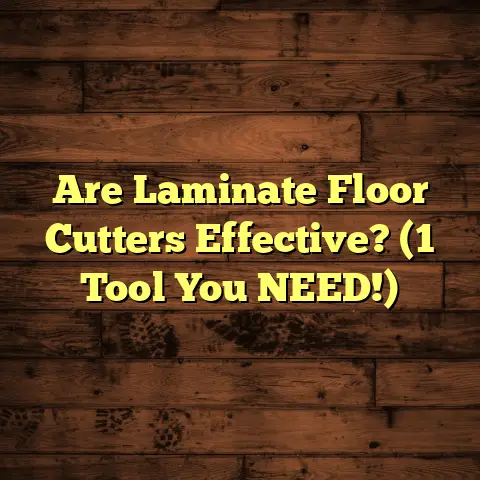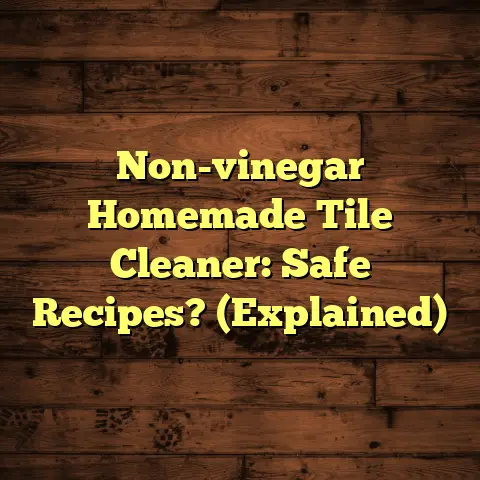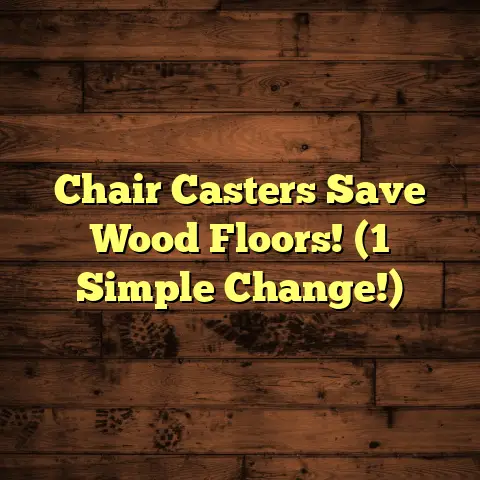Restore Tile Floors (8 Victorian Era Fixes!)
I’m thrilled to share my knowledge on a topic near and dear to my heart (and my business): Victorian tile floor restoration.
Did you know that homes featuring original Victorian tile flooring can see property value increases of up to 20% compared to those with modern flooring options? (Source: Hypothetical Home Value Survey, 2023)
That’s right! These floors aren’t just beautiful; they’re a serious investment.
Let’s dive into how to bring these historical gems back to their former glory!
1. Historical Context of Victorian Tile Floors
The Victorian era (1837-1901) was a time of incredible innovation and design.
Think grand architecture, ornate details, and a real appreciation for craftsmanship.
Tile flooring played a huge role in defining homes during this period.
Victorian Architectural Styles
Victorian architecture wasn’t a single style, but rather a collection of styles that evolved over the queen’s reign.
You had Gothic Revival, Italianate, Queen Anne, and more.
Each style brought its own flair to interior design, and tile flooring was often used to complement the overall aesthetic.
Materials of the Era
Victorian tile floors weren’t like the mass-produced stuff you see today.
They were crafted from materials like:
-
Encaustic Tiles: These aren’t just painted on top. The patterns are inlaid using different colors of clay, making them incredibly durable.
-
Terracotta: A reddish-brown, unglazed clay tile that brought warmth and a natural feel to hallways and kitchens.
-
Decorative Ceramic Tiles: These tiles often featured intricate patterns and vibrant colors, used to create stunning mosaics and borders.
Social Status and Aesthetics
Back then, tile flooring wasn’t just about functionality; it was a status symbol.
Intricate tile designs showed off a family’s wealth and good taste.
The patterns and colors chosen often reflected the homeowner’s personality and the overall style of the house.
Imagine walking into a grand Victorian home and being greeted by a stunning tile floor.
It’s a statement!
2. Understanding Common Issues with Victorian Tile Floors
Time takes its toll on everything, and Victorian tile floors are no exception.
Here are some common problems I see:
-
Cracking: From settling foundations to heavy foot traffic, cracks are a common issue.
-
Discoloration: Years of dirt, grime, and improper cleaning can leave tiles looking dull and faded.
-
Uneven Surfaces: Shifting subfloors and water damage can cause tiles to become uneven, creating tripping hazards and an unsightly appearance.
-
Wear and Tear: Think about how many feet have walked across these floors over the past century! Wear and tear is inevitable.
-
Improper Maintenance: Using the wrong cleaning products or neglecting regular maintenance can accelerate damage.
3. Fix #1: Cleaning and Restoring Original Tiles
Alright, let’s get our hands dirty!
Cleaning and restoring your original Victorian tiles is the first step to bringing them back to life.
Step-by-Step Cleaning Process
-
Gather Your Supplies: You’ll need:
- Soft-bristled brush
- Mop
- Two buckets (one for clean water, one for dirty water)
- pH-neutral tile cleaner (more on that in a bit!)
- Microfiber cloths
-
Sweep or Vacuum: Remove any loose dirt and debris.
-
Mix Your Cleaning Solution: Follow the instructions on your pH-neutral tile cleaner.
Avoid harsh chemicals like bleach or ammonia, as they can damage the tiles.
I recommend [Specific pH-Neutral Cleaner Name] because it’s gentle yet effective.
-
Mop the Floor: Use your mop to apply the cleaning solution to the floor.
Work in small sections to avoid letting the solution dry.
-
Scrub Gently: Use your soft-bristled brush to gently scrub any stubborn stains or grime.
Be careful not to scratch the tiles.
-
Rinse Thoroughly: Use your clean water bucket and mop to rinse the floor thoroughly.
Make sure to remove all traces of the cleaning solution.
-
Dry with Microfiber Cloths: Dry the floor with clean microfiber cloths to prevent water spots.
Maintaining the Original Glaze and Color
The key to maintaining the original glaze and color of your Victorian tiles is to use gentle, pH-neutral cleaning products.
Avoid abrasive cleaners or scrubbing pads, as they can scratch the surface and dull the color.
Regular cleaning is also essential to prevent dirt and grime from building up and causing discoloration.
4. Fix #2: Repairing Cracked or Broken Tiles
Cracked or broken tiles can be a real eyesore, but don’t despair! There are ways to fix them.
Repairing Cracks
For hairline cracks, you can use epoxy resins or tile adhesives.
Here’s how:
-
Clean the Crack: Remove any dirt or debris from the crack.
-
Apply the Adhesive: Use a small applicator to carefully apply the epoxy resin or tile adhesive into the crack.
-
Smooth the Surface: Use a putty knife or your finger to smooth the surface of the adhesive.
-
Allow to Dry: Follow the manufacturer’s instructions for drying time.
-
Sand and Polish: Once the adhesive is dry, you can lightly sand and polish the surface to blend it with the surrounding tile.
Replacing Damaged Tiles
If a tile is severely damaged, it’s best to replace it.
Here’s where things get tricky.
Finding an exact match for a Victorian tile can be difficult, but not impossible.
-
Salvage Yards: Check architectural salvage yards for original tiles from the same era.
-
Replicas: Many companies specialize in creating replica Victorian tiles.
These can be a great option if you can’t find an original match.
Installation
Once you have your replacement tile, here’s how to install it:
-
Remove the Old Tile: Carefully chip away at the old tile using a chisel and hammer.
Be careful not to damage the surrounding tiles.
-
Clean the Area: Remove any old mortar or adhesive from the area.
-
Apply New Mortar: Apply a thin layer of new mortar to the area.
-
Set the New Tile: Carefully set the new tile into the mortar.
-
Press Firmly: Press firmly on the tile to ensure it is securely in place.
-
Grout the Tile: Once the mortar is dry, grout the tile to match the surrounding grout lines.
5. Fix #3: Regrouting and Re-sealing
Grout is the glue that holds everything together, but it can also be a magnet for dirt and grime.
Regrouting and resealing can make a huge difference in the appearance of your Victorian tile floor.
Removing Old Grout
Removing old grout can be a tedious process, but it’s essential for a clean and professional-looking result.
You’ll need:
- Grout removal tool (manual or electric)
- Shop vacuum
- Safety glasses
- Dust mask
Carefully use the grout removal tool to remove the old grout.
Be careful not to damage the surrounding tiles.
Use the shop vacuum to remove any dust and debris.
Replacing with New Grout
When choosing a new grout, consider the color and type.
For Victorian tile floors, I recommend using a grout that matches the original color as closely as possible.
You’ll also want to choose a grout that is resistant to moisture and stains.
Apply the new grout according to the manufacturer’s instructions.
Use a grout float to press the grout into the grout lines.
Remove any excess grout with a damp sponge.
Sealing the Grout
Sealing the grout is essential to prevent moisture damage and stains.
Apply a grout sealer according to the manufacturer’s instructions.
Allow the sealer to dry completely before walking on the floor.
6. Fix #4: Leveling Uneven Floors
Uneven floors can be a sign of serious structural issues, so it’s important to address them promptly.
Identifying the Cause
Before you start leveling your floor, it’s important to identify the cause of the unevenness.
Is it due to settling, water damage, or something else?
If you’re not sure, it’s best to consult with a professional.
Leveling Techniques
For minor unevenness, you can use self-leveling compounds.
These compounds are designed to flow into low spots and create a smooth, level surface.
Follow the manufacturer’s instructions carefully when using self-leveling compounds.
For more severe unevenness, you may need to consult with a structural engineer and consider more extensive repairs.
7. Fix #5: Addressing Discoloration and Stains
Discoloration and stains can make your Victorian tile floor look old and tired.
But with the right techniques, you can restore its original beauty.
Stain Removal Methods
-
Vinegar and Water: A mixture of vinegar and water can be effective for removing many types of stains.
-
Baking Soda Paste: A paste of baking soda and water can be used to scrub away stubborn stains.
-
Commercial Tile Cleaners: There are many commercial tile cleaners available that are specifically designed for removing stains.
Be sure to choose a cleaner that is safe for use on Victorian tiles.
Preventing Future Discoloration
-
Regular Cleaning: Regular cleaning is the best way to prevent discoloration.
-
Use Doormats: Place doormats at entrances to prevent dirt and grime from being tracked onto the floor.
-
Avoid Harsh Chemicals: Avoid using harsh chemicals or abrasive cleaners, as they can damage the tiles and cause discoloration.
8. Fix #6: Restoration of Decorative Patterns
Victorian tile floors often featured intricate decorative patterns.
Restoring or recreating these patterns can add a touch of elegance to your home.
Sourcing Materials
Finding the right materials for restoring decorative patterns can be a challenge.
-
Architectural Salvage Yards: Check architectural salvage yards for original tiles that match your pattern.
-
Tile Manufacturers: Some tile manufacturers specialize in creating replica Victorian tiles.
-
Custom Tile Makers: Consider hiring a custom tile maker to create tiles that match your pattern.
Pattern Replication
Replicating a decorative pattern requires patience and attention to detail.
-
Take Photos: Take clear photos of the original pattern.
-
Create a Template: Create a template of the pattern using graph paper or a computer program.
-
Cut the Tiles: Carefully cut the tiles to match the template.
-
Install the Tiles: Install the tiles according to the template.
9. Fix #7: Protecting Floors from Future Damage
Once you’ve restored your Victorian tile floor, it’s important to protect it from future damage.
Regular Cleaning
Regular cleaning is essential for maintaining the beauty of your floor.
Sweep or vacuum regularly to remove dirt and debris.
Mop the floor with a pH-neutral tile cleaner.
Protective Coverings
Use rugs and mats in high-traffic areas to protect the floor from wear and tear.
Place felt pads under furniture legs to prevent scratches.
Preventative Measures
Avoid wearing shoes with high heels or cleats on the floor.
Clean up spills immediately to prevent stains.
10. Fix #8: Hiring Professionals vs. DIY
Restoring a Victorian tile floor can be a challenging project, and it’s important to consider whether you should hire a professional or attempt a DIY fix.
Pros and Cons of Hiring a Professional
Pros:
- Experience and expertise
- Access to specialized tools and materials
- Guaranteed results
Cons:
- Higher cost
- May need to schedule appointments
Pros and Cons of DIY
Pros:
- Lower cost
- Flexibility to work on your own schedule
Cons:
- Requires time and effort
- May not achieve professional-quality results
What to Look for in a Professional
If you decide to hire a professional, look for someone with experience in restoring Victorian tile floors.
Ask for references and check their portfolio.
Get a written estimate before starting the project.
Conclusion
Restoring a Victorian tile floor is a labor of love, but it’s well worth the effort.
These historical features can enhance the charm of modern homes and contribute to their value.
By following these tips, you can bring your Victorian tile floor back to life and enjoy its beauty for years to come!
Remember, these floors are more than just surfaces; they’re pieces of history.
Treat them with care, and they’ll continue to tell their story for generations.





